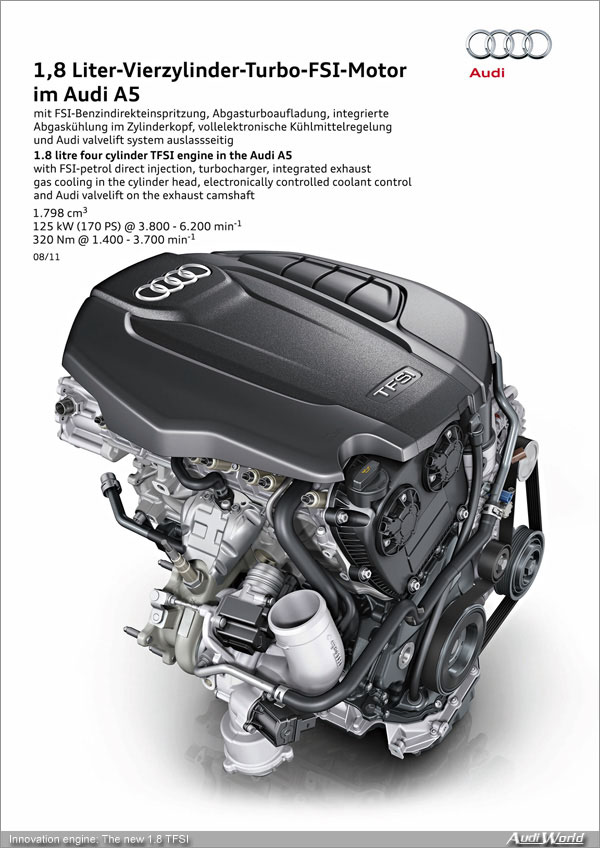August 04, 2011
Source: Audi of America
· Ample power and minimal consumption: 125 kW (170 hp) and
320 Nm (236.02 lb-ft) torque, but just 5.7 liters per 100 km (41.27 US mpg)
· New solutions in fuel injection and other fields of technology
· Fully electronic coolant regulation system
Ingolstadt – The engines in the updated A5 family set new standards for sportiness and efficiency. Even the base engine, the completely redesigned 1.8 TFSI, showcases the full extent of Audis technological competence. The engineers have developed innovative solutions in numerous fields of technology to achieve surprisingly strong performance with minimal fuel consumption.
The high-end four-cylinder engine displaces 1,798 cm3 and delivers a brawny and constant 320 Nm (236.02 lb-ft) to the crankshaft between 1,400 and 3,700 rpm. Peak output of 125 kW (170 hp) is achieved at 3,800 rpm. With a manual transmission, the 1.8 TFSI accelerates the Audi A5 Coupé from zero to 100 km/h (62.14 mph) in 7.9 seconds on its way to a top speed of 230 km/h (142.92 mph). Despite all this power, it consumes just 5.7 liters of fuel per 100 km (41.27 US mpg) on average, which corresponds to best-in-segment emissions of 134 grams of CO2/km (215.65 g/mile). Consumption has been reduced by 21 percent compared with the previous model engine.
Combustion behavior was a particular focus of the development work. In addition to FSI direct injection, the 1.8 TFSI also uses indirect injection. This system injects the fuel at the end of the intake manifold near the tumble valves, where it is swirled intensively with the air. Indirect injection is used in the part-load range. It reduces fuel consumption and particulate emissions to such an extent that the four-cylinder engine already complies with the limits of the future Euro 6 standard, which does not enter into force until 2015.
The rail pressure of the FSI system has been increased from 150 to 200 bar. The direct injection system is active when starting off and at higher loads. It can perform two or three individual injection operations per work cycle. To further optimize gas exchange, the valve control system has been given greater operating freedom. The Audi valvelift system, which adjusts the lift of the valves in two stages, is active on the exhaust side. The two camshafts can be adjusted through 30 or 60 degrees of crankshaft angle.
Fully electronic coolant regulation system
The innovative thermal management of the four-cylinder engine features a new fully electronic coolant regulation system. Two fast-switching, rotating cores, which are consolidated in a module and driven by an electric motor via a screw drive, control the flow of coolant. One of their primary objectives is to bring the motor oil up to operating temperature as quickly as possible following a cold start. This is done by keeping the coolant in the crankcase for a relatively long time. The cabin heating runs off of a separate loop in the cylinder head. The main radiator, which dissipates the heat to the environment, does not come into play until the latest possible moment.
The new rotating core module can set the water temperature between 85 and 107 degrees Celsius as a function of load and rpm to always achieve the best compromise between minimal internal friction and thermodynamic efficiency. Switchable valves throughout the cooling system manage heat flows between the engine, the heat exchanger for the transmission and the cabin. All together, the thermal management system reduces the CO2 emissions of the 1.8 TFSI by around 2.5 g per 100 km (4.02 g/mile).
This concept benefited from the integration of the exhaust manifold into the water-cooled cylinder head. Because this also reduces the exhaust gas temperature, it is not necessary with the 1.8 TFSI to enrich the mixture at full load, which reduces fuel consumption significantly when driving sportily.
The turbocharger in the 1.8 TFSI is also an all-new design that develops the high relative boost pressure of up to 1.3 bar very systematically. Key features include a turbine wheel made from a new alloy that can withstand exhaust temperatures of up to 980 degrees Celsius, the oxygen sensor mounted directly upstream of the turbine wheel, a pulsation damper, a compressor wheel machined from a solid blank and an electric wastegate actuator that adjusts the boost pressure particularly quickly and precisely to further reduce fuel consumption.
Engine weight has been reduced from 135 to 131.5 kilograms (297.62 to 289.91 lb). The new turbocharger/cylinder head module, a new casting process for the gray cast iron crankcase that reduces wall thickness to roughly three millimeters (0.12 in) and the crankshaft with four rather than eight counterweights and reduced main bearing diameters all contributed to this weight reduction. The pistons are made of new, high-strength alloy. Lightweight polymers are used for the oil pan, and many screws are made of aluminum.
Internal friction has also been drastically reduced by the use of an innovative coating on the piston skirts and by mounting the two balance shafts that counteract the second-order inertial forces in roller bearings. The regulated oil pump requires little energy itself, and the oil-jet cooling for the piston heads is controlled via a high-precision electric system.
|

